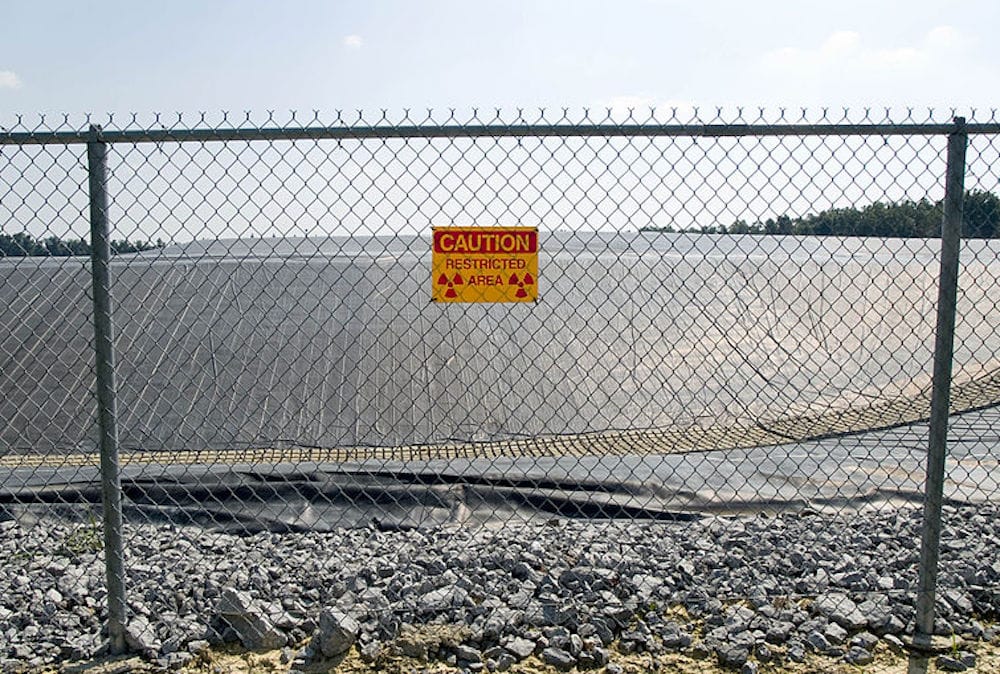
[Image above] A radiation warning sign at the Maxey Flat Low Level Radioactive Waste site in Maxey Flat, Ky. New research suggests that vitrification, a common method for nuclear waste disposal, may be less stable than thought. Credit: RRJackson, Wikimedia (CC BY-SA 3.0)
Update 09/10/2020 – Following feedback generated by the OSU press release, the authors have released another press release through the Pacific Northwest National Laboratory more clearly explaining the results of the study. They also published a post-publication “Matters Arising” commentary through Nature to clarify how much corrosion of nuclear waste matrices matter.
Even as several countries lay plans to build hundreds of new coal plants, overall many countries are instead opting to lay plans for renewable energy infrastructure—the world’s total renewable-based power capacity is forecast to grow by 50% during 2019–2024, according to the International Energy Agency.
Solar and wind energy in particular drive this growth. However, many people hotly debate if another type of energy should also drive growth away from coal—nuclear.
Whether nuclear should be classified as renewable or not is debatable, but it is generally accepted as sustainable, and vocal supporters believe it must be part of the energy solution.
One argument that supporters of nuclear energy make is that we have the technological capability to safely store nuclear waste, specifically through waste vitrification.
Waste vitrification involves melting nuclear waste together with glass-forming additives to turn the waste into glass, which is then placed in stainless steel canisters and typically buried deep underground.
Limitations of waste vitrification include a high initial investment cost, high operational cost, and complex technology. But the stability of the final waste glass often is considered worth the investment.
However, the duration of that stability may be much shorter than we realized.
A new study led by researchers at The Ohio State University shows that corrosion of nuclear waste storage materials could be significantly accelerated because of changes in chemistry of the nuclear waste solution.
The researchers explain in the paper that during long-time exposure in the repository, after a cooling period, an aqueous environment can form outside the waste canister. Corrosive electrolytes in the surrounding liquid can lead to pitting corrosion in the metallic canisters, triggering multiple reactions.
“Anodic dissolution of the SS [stainless steel] generates metal cations, which hydrolyse to form protons and strongly increase the local acidity,” the researchers write in the paper. “This acidic environment further corrodes the SS and glass, which leads to the release of radionuclides. Meanwhile, corrosion of the glass also releases various ions that could cause a feedback effect on the SS corrosion.”
Essentially, “It creates a super-aggressive environment that can corrode surrounding materials,” Xiaolei Guo, lead author and deputy director of OSU’s Center for Performance and Design of Nuclear Waste Forms and Containers, explains in an OSU press release.
To explore this process, the researchers pressed glass or ceramic waste forms against stainless steel and immersed them in solutions for up to 30 days, under conditions that simulate those under Yucca Mountain in Nevada (the controversial site for a proposed nuclear waste repository). The experiments showed “severe” and “localized” corrosion on the stainless steel and ceramic waste, while parts of the glass showed enhanced corrosion.
“Apparently, the most effective approach to eliminate the interfacial damage is to completely isolate water from the disposal system,” the researchers write, “which is challenging given the unpredictably of the geological environment over extremely long periods of time.”
“Therefore, similar to all current performance assessment models, it must be assumed that water will eventually reach the immobilized waste,” they add. As such, the compatibility of different barriers should be carefully examined and optimized, especially in terms of “the hydrolysis of ions that may be released and accumulated at the materials interfaces.”
In a commentary piece (*paywalled*) published in The Energy Daily, two scientists discuss some possible limitations of the study. The Swiss office of INTERA, an employee-owned geoscience and engineering consulting firm, also posted a blog (in German) critiquing the study.
The paper, published in Nature Materials, is “Self-accelerated corrosion of nuclear waste forms at material interfaces” (DOI: 10.1038/s41563-019-0579-x).
Update 02/14/2020 – Links to commentary pieces by The Energy Daily and INTERA added for further insight
Author
Lisa McDonald
CTT Categories
- Energy
- Environment
- Glass


